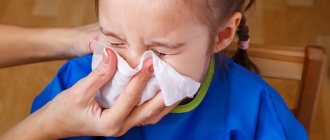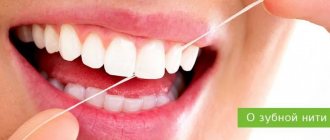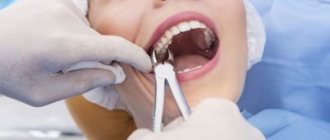When teeth start cutting
There is no exact answer as to what time a child’s teeth are cut – the timing varies from person to person. However, you can focus on the average, standard periods of eruption approved by WHO:
- the lower incisors appear at 6–7 months;
- upper – at 7–8 months;
- upper lateral incisors – at 8–9 months;
- the lower ones are closer to a year.
According to the standard, a one-year-old child must have eight baby teeth.
From one year to one and a half years, the child acquires larger teeth - upper and lower molars, and from fifteen to twenty months - upper canines, which are also called “ocular.” The fact is that the optic nerve runs next to them, so these teeth are often more difficult for the child than others. Irritation of the nerve causes sharp pain and sometimes watery eyes.
It can be difficult even for a doctor to understand that the first teeth are being cut. After all, this process is often accompanied by an increase in temperature, changes in stool and mood, and refusal to eat.
The first manifestations of speech in children are cooing. When they grow up a little, they begin to pronounce simple sound combinations and words (for example, “mom”, “dad”, etc.). The next achievement in the development of a child’s speech is his ability to compose simple sentences from words. But when can we expect a child to achieve this or that achievement in speech development? Let's look at how children begin to talk, how to help them develop these skills, and what abnormalities in speech development a child may have.
How children learn to speak
Children learn to speak gradually, going through several stages in this process. Surprisingly, the first stage takes place in the womb. Studies have shown that in the areas of the fetal brain responsible for speech, activity appears as early as the 7th month of pregnancy. It appears every time mom speaks louder than usual or pronounces words slowly and emphatically. Experts believe that such a change in speech style is a kind of language lesson for the child.
By the end of pregnancy, the fetus can already hear words. Newborn children have limited but important knowledge, for example, the ability to distinguish their native speech from a foreign one. However, the child's speech development occurs step by step.
When children start talking
Babies begin to coo at around two months of age. These sounds form the basis for further speech development. At the age of four months, the child begins to babble. Development continues, and at twelve months the child usually begins to speak simple words. At two years old, the child pronounces words meaningfully, and at three years old, he begins to talk with others. Like the development of any other area, a child’s speech development goes through certain stages.
Stages of child speech development
At a certain age, children reach different indicators of speech development. Let's take a closer look at them.
| Age | Index |
| First stage: 1–3 months | The child coos and makes different sounds in different tones. |
| Second phase: 2–6 months | The child imitates the sounds of the surrounding world, pronounces combinations of vowel sounds and individual consonants ([m], [p], [b], etc.). |
| Third stage: up to 12 months | The child pronounces the first words: “dad”, “mom”, “baba”, interjections “o”, “ou”, etc. to express emotions. |
| Fourth stage: up to 18 months | The child can pronounce 10 or more words, link several words into a simple sentence, and say “no.” |
| Fifth stage: up to 24 months | The child makes sentences of 4–5 words, says simple phrases (for example, “give me more”), words such as “hello,” “goodbye,” “let’s go.” His vocabulary is about 50 words. |
| Sixth stage: up to 36 months | The child can name objects that he sees around him, distinguishes names, gender and age, and can carry on a simple conversation. |
At each stage, the child has its own development indicators. Let's take a closer look at them.
1–3 months
- The child begins to gurgle. These are the first sounds he makes. The child experiments with the vocal apparatus, using sounds to attract the attention of the parents.
- The child makes sounds indicating that he is comfortable . Often parents can hear him pronounce the sounds [m] or [o]. This is how he shows that he is comfortable or calms himself down.
2–6 months
- The child babbles and imitates surrounding sounds. The child babbles, making arbitrary sounds. Most often, in this way he imitates the sounds he hears around him. Through imitation, the child learns new words.
- The child pronounces vowels and sometimes consonants. It is easier for a child to pronounce vowel sounds because he does not have to make complex movements with his tongue. Certain consonant sounds (for example, [p], [b]) are easier to pronounce than others, so children usually pronounce them one of the first.
Up to 12 months
- The child speaks his first words. By the first year, the child speaks the first words with an easy-to-pronounce set of consonants - “mama,” “dad,” “baba.” At first, the child pronounces these words arbitrarily, without putting meaning into them. Gradually he learns to address these words correctly.
- The child pronounces sound combinations for exclamation . You may often hear your child “ouch” when he drops a toy on the floor. Interjections are part of a child’s vocabulary; he begins to use them by the age of one.
12–18 months
- The child says a few words. The first words that a child says are the names of objects that he sees around him (toys, bottle, clothes, etc.). The child names the object that he wants to use at the moment, for example, he can say “bottle” when he is hungry.
- The child says no. The child may shake his head and say “no.” Using the word “no” means better interaction between language and cognitive skills.
18–24 months
- The child repeats the words. By the age of two, the child repeats words and phrases heard from other people. At a younger age, he simply babbled, imitating the speech of those around him, without trying to pronounce words correctly.
- The child pronounces up to 50 words. His vocabulary includes the words "hello", "bye", "let's go", etc. As the child's vocabulary increases, he learns to compose simple sentences consisting of 4-6 words.
24–36 months
- The child uses pronouns in speech. This means that he understands the language rules for using the 1st and 3rd person.
- The child keeps up the conversation. Now you can have a full conversation with your child. Achieving this indicator means that the child has fully mastered all the speech skills that he can achieve in preschool age.
A child develops language skills best when he receives enough support from his parents.
How parents can help their child learn to speak
Let's look at several ways to speed up a child's speech and language development.
1. Start speaking to your child in his language as early as possible. Baby tongue is a child's way of saying words and making sentences. It is simpler and more understandable for a child. Talk to him as early as possible and he will be able to pick up the language at a simple level. Research shows that children whose parents spoke their language from an early age have a larger vocabulary than their peers by age three.
2. Read and sing. This increases the child's interest in new words and sentences. Read age-appropriate books to your child and sing to him. This will stimulate his speech development.
3. Encourage your child to imitate the speech of others. Let him repeat your words to the best of his ability. The child's speech will be slurred at first, but as the child gets older, he will repeat your words more accurately. This will provide the basis for meaningful sentence writing.
4. Describe people and objects. Show your child various objects and name them. Introduce your child to relatives, tell them their names and degree of relationship. The more you use nouns, the more the child associates objects with their names and develops vocabulary.
5. Ask your child questions and keep the conversation going. When your child turns 3, ask him questions if he wants something or has any problem. Questions force the child to look for answers. Also, at the age of three, you can have long conversations with your child to develop his speech skills.
6. If you speak several languages, speak to your child in your native language. Experts advise parents to speak to their child in the language that is most comfortable for them. This way, the child will learn the language better, and it will be easier for parents to monitor the baby’s progress.
The methods discussed will help your child develop speech skills faster and easier. However, on this path you must remove all possible obstacles.
How to ensure proper speech development for your child
Follow the tips below to ensure your child's speech development is healthy.
1. Let your child experiment. Give your child as much time as necessary to learn new words. Allow him to experiment with combinations of consonant sounds - this will help the child develop his speech skills.
2. Eliminate sources of background noise. When reading or singing to your child, turn off the TV and radio and eliminate any possible sources of background noise. This will help the child concentrate and not be distracted.
3. Limit the time your child spends watching a TV or computer screen. Experts note that modern children under three years of age spend too much time watching TV, computers, tablets, etc. Research shows that this slows down their speech development. It is better to devote this time to live communication with the child.
Sometimes children have certain problems with speech development. Parents can help their child cope with them.
What to do if the child does not speak
Sometimes parents feel that their child is lagging behind in speech development. But a slight delay should not be a cause for concern. Delayed speech development is not necessarily a symptom of any disorder. Some children just take longer to start speaking than others. Be patient and support your child.
In some cases, the following problems may occur:
- Babies born prematurely may start speaking later. Remember that premature babies tend to develop language skills later than others, but they catch up over time.
- diseases that a child suffers in the womb or at birth can lead to delays in speech development. Infections suffered by the mother during pregnancy, illnesses suffered by the baby at birth, side effects of medications, and even poor health and low birth weight of the baby can all lead to delays in speech development. However, children make slower progress in developing general language skills.
If you doubt that your child's speech development is progressing at a normal pace, you should pay attention to a number of signs that indicate this.
Danger signal in a child’s speech development
Children with speech delays exhibit the following symptoms:
- At 12 months, the child does not coo and cannot say “dad” or “mama.”
- At 18 months, the child prefers gestures to verbal communication, his vocabulary is only 3-4 words.
- At 24 months, a child cannot repeat words after adults, even if they repeat them several times. He also doesn't answer simple questions.
- At 36 months, the child cannot name objects and the names of his immediate family, does not communicate with his parents, speaks in an unusual tone, and his vocabulary does not develop.
Experts say that speech development delays occur in approximately 20% of all children. In most cases, these delays are temporary, and the child overcomes them as he grows. One way or another, if you are faced with a delay in the speech development of a child, first of all you must understand what caused it.
Causes of speech delays in children
Let's consider factors that can directly or indirectly interfere with the speech development of children:
1. Autism spectrum disorders. An infant with this disorder may have a small vocabulary and difficulty understanding multi-meaning words. A child with autism spectrum disorder cannot carry on a conversation. However, not all cases of autism spectrum disorder lead to delays in speech development; in some cases, speech development proceeds normally.
2. Hearing disorders. Because a child learns speech by listening, any hearing loss can negatively impact speech development. These include congenital diseases of the hearing organs and injuries, leading to the fact that the child cannot hear the speech of others.
3. Neurological disorders. Various neurological problems (cerebral palsy, congenital mental retardation, etc.) can cause delays in speech development. Most of these disorders also cause hearing impairment. In disorders such as apraxia of speech, the functioning of the brain is not impaired, but malfunctions occur in the neurons that control jaw movements.
4. Behavior problems. Some children exhibit language disorders only in certain settings (for example, school). This disorder is called selective muteness. The child may be healthy and just need a boost of self-confidence to begin speaking normally. This disorder is quite rare, occurring in approximately 1% of children.
If you suspect a speech delay in your child, you should contact your pediatrician immediately.
How to determine speech delay in a child
If the pediatrician suspects problems with speech development in a child, he will refer the child for examination to a speech pathology specialist who can determine the delay in speech development. In this case, the following parameters of the child’s speech are examined:
- hearing. Hearing impairment can affect the development of speech skills. Therefore, first of all, if a delay in speech development is suspected, the child’s hearing is examined;
- physical defects. Deformations of the palate or lip may interfere with speech. The child is examined for physical defects of the upper respiratory tract that could potentially cause speech delay;
- speech perception. The extent to which the child can understand and interpret speech is examined;
- expressiveness of speech. It examines how long a child can maintain a conversation and how many words he knows. The clarity of the child's speech is also taken into account;
- use of gestures. Does the child prefer gestures to words? This may be a sign that the child has problems with speech development. During the examination, doctors pay attention to this symptom.
After the examination, the doctor determines the child’s diagnosis. If a child is diagnosed with any disease, he will be prescribed appropriate treatment.
Treatment of speech delays in children
Doctors use speech therapy for treatment. The procedures involved in this process may vary in each individual case. However, there are generally accepted procedures used in the treatment of speech delays in children:
- surgical treatment of hearing or speech defects. If the cause of delayed speech development in a child is physical defects, surgical intervention is used. After this, you can proceed to the next stages of treatment;
- development of speech skills. The child is taught through music, songs, conversations and books. The specialist conducts classes with the child aimed at developing his speech skills appropriate for his age. Conversations with the child help improve his pronunciation;
- strengthening the speech apparatus. To develop correct pronunciation, the child performs exercises aimed at strengthening the muscles of the lower jaw. The doctor may recommend exercises that the child should do while eating to develop proper jaw movements.
The length of treatment and procedure depend on the specific language development problem the child is experiencing. Parents can also help their child cope with these problems.
How parents can help their child cope with speech delays
To help a child overcome speech delays, psychologists recommend that parents take the following measures:
- talk to your child. Young children do not understand the meaning of words, but they hear and respond to sounds. Talk to your child from a very early age, repeat the sounds he makes. This may be a pointless exercise, but it is the basis for further speech development;
- count and name objects for your child. For example, when your child is building a tower of blocks, count the number of blocks out loud so that your child can hear you. Point to objects and name them. Call people in the same room with you by name;
- ask questions. Children understand questions, so ask your child what he wants. If he cries or becomes hysterical, ask him what's wrong. Questions motivate the child to use words instead of gestures to state their needs;
- read to your child. Psychologists recommend reading to children from a very early age. For reading, choose books with pictures: show your child the pictures and name what is depicted in them. As your child gets older, let him choose his own books to read;
- Sing nursery rhymes to your child. Don't underestimate nursery rhymes. They may seem frivolous to you, but in fact they help the child develop speech. Sing songs to your child, read children's poems, and soon he will begin to repeat after you. Young children repeat individual sounds after their parents, while older children try to pronounce whole words. In any case, it helps develop the child’s speech.
Parents usually have many questions about their child’s speech development. Let's try to deal with the most common of them.
Common questions about speech development in children
1. At what age can a child start talking?
The child begins to talk no earlier than 7 months. However, he begins to consciously pronounce words only after 1 year.
2. How do speech and language development differ?
Speech is the ability to communicate using verbal means of communication. Language includes both verbal and non-verbal means, as well as written language. Children cannot write, so newborns most often use nonverbal communication. Verbal communication is an indicator of progress in a child's development.
3. When do children begin to speak fluently?
The skills needed for fluent speech usually develop in a child around 4–5 years of age. At 5 years old, the child usually speaks fluently.
4. How do pediatricians assess speech delays in children?
Pediatricians use special procedures to determine how a child responds to words and questions. As a result of such tests, they determine the level of speech development of the child and possible problems.
5. How are speech delays in children treated?
It depends on the reason causing the delay. For example, in the case of autism, there is no cure for speech delay, but it can be successfully managed by changing the child's lifestyle. Disorders such as apraxia are treated with psychotherapeutic methods. In any case, successful treatment of speech development disorders is facilitated by early identification of the problem and intervention.
Children are naturally inclined to learn to speak. Scientists say that they have a genetic predisposition to this. However, parents can encourage the child to develop speech at a faster pace. Let your child speak and make sure he reaches speech development milestones on time. With a little effort, your child will not be able to be silenced in a few years.
Formation of the dentition
The article tells how to understand that a child is teething, and about ways to help him with pain and inflammation of the gums. But first, a few words about the process of dentition formation.
The formation of absolutely all teeth occurs in the fifth month of intrauterine development. They remain in a “frozen” state and begin to grow immediately before eruption. Therefore, if a child has no teeth by 9-12 months, radiography is prescribed - a study that allows one to evaluate their formation and location.
World War I
As production developed, industrialists began to pay part of their salaries in coupons, some of which were used to obtain food and goods. At the end of the 19th century, special tokens even appeared in Russia for the right to receive water from water intake booths as water pipelines were built.
However, in the usual sense, cards appeared during the First World War - as the conflict progressed, the state experienced a shortage of industrial goods, many agricultural areas found themselves in the combat zone, and in others there was an acute shortage of labor. Already in 1915, coupons for bread and sugar began to be distributed in a number of cities.
Subsequently, self-government bodies, zemstvo organizations, and merchants began to introduce cards into circulation. Such systems remained local and aimed at supporting the most vulnerable segments of the population. For example, children and the sick received benefits when receiving meat and milk. By the beginning of 1917, the practice of distributing bread, meat and sugar using coupons was already widespread in a number of large cities, and under the Provisional Government it became widespread. So, from April 29, 1917, grain - rye, wheat, spelt, millet, buckwheat and other crops - were given exclusively by ration cards.
Similar measures were applied after the October Revolution. In Soviet Russia, the card system was introduced against the backdrop of the policy of “war communism” and surplus appropriation. Thus, citizens received bread, cereals, sugar and sunflower oil. After the transition to the NEP policy in 1921, the cards were abolished.
What affects the timing of teething?
Processes in the body are individual, including timing. The age at which the first teeth appear is determined by a number of factors:
- Heredity.
- The intrauterine period and negative factors affecting the fetus (for example, a pregnant woman taking certain medications).
- Nutrition for the expectant mother during the period of waiting for the baby and breastfeeding.
Introduction of complementary foods, etc.
Teeth are out of time: why are they “in a hurry” or delayed?
The diagram shows the average time for the appearance of baby teeth, but for some babies they may erupt a couple of months earlier, for others later. Experts consider a deviation of 1-2 months to be the norm, because the timing of the appearance of the first teeth can be influenced not only by the menu of the mother and child, but also by heredity and even the season of birth of the baby (those born in spring and winter have teeth earlier than summer and autumn babies).
A deviation from the norm is either the complete absence of teeth in a one-year-old child, or their early eruption at the age of 2-3 months, or the birth of a child with teeth. In this case, the baby must be shown to a pediatrician, endocrinologist and dentist, who will promptly notice the possible development of rickets or endocrine disease. The “schedule” of teething is also important, so parents should pay attention to the sequence of appearance of baby teeth according to the natural pattern laid down by nature.
Teething symptoms
- there may be a slight fever;
- anxiety - the child becomes capricious, sleeps poorly, often wakes up at night;
- decreased appetite;
- excessive salivation and, as a result, redness of the skin around the mouth;
- swelling and redness at the site of tooth eruption, possible formation of hematomas on the gum mucosa;
- increased need for the baby to chew on something: pacifier, toys, fingers.
There are children whose teeth appear asymptomatically and even unnoticed by their parents. But, as a rule, this process is accompanied by an individual combination of the signs given in the list above.
How can you tell if your baby is teething?
Teething in children, symptoms:
Capricious behavior is associated with the movement of the tooth through the gum: this causes pain and itching. The baby tries to scratch his gums with any means at hand, bites, and gets nervous. Help your child relieve unpleasant symptoms by purchasing a special teether.
Deterioration of appetite and even refusal of food (especially if it is hot). After taking the breast, the baby may try to bite the nipple. Help your baby by massaging his gums a little before feeding.
Unusual drowsiness, fatigue, increased body temperature, excessive salivation. Normally, a child’s temperature during teething should not be higher than 37.5-38 degrees, and a higher temperature indicates other problems not related to teeth. The reason for the increase in temperature is inflammation of the gums, and abundant saliva creates a protective barrier against infections, performing a bactericidal and anti-inflammatory function. How long does the temperature last during teething? No more than 3-4 days, without a sharp increase in temperature to high levels.
Weakening of stool (stool acquires the consistency of “soft porridge” without changing its usual color), as well as a slight increase in frequency.
However, children should not have diarrhea during teething; this is an alarming symptom.
Parents need to know:
If a child’s temperature rises above 38 degrees, and is accompanied by diarrhea, vomiting, impaired consciousness and a rash, such symptoms are not at all associated with teething, but signal the presence of an infection. With such symptoms, it is necessary to urgently call an ambulance or show the child to a pediatrician.
Toothpastes for one-year-old children and infants
To start brushing children's teeth using toothpaste, it is not necessary to wait until the child is one or three years old. Most toothpastes are indicated for children over 2 years of age, however, there are a number of manufacturers whose product lines include good fluoride-free toothpastes suitable for children under one year of age. They are completely harmless and can be swallowed. Such products can be found among the brands:
- ROCS
- Elmex.
- Splat.
- Lacalut.
Each toothpaste indicates at what age it is approved for use - you need to brush your child’s teeth only with a product that is not contraindicated for him and is suitable for comprehensive care of children’s teeth.
When starting to brush the teeth of a child under one year old using toothpaste, you need to monitor his reaction. Some babies may develop allergies, so at the first symptoms of a rash or an incomprehensible cough, you should stop using the paste and show your baby to a doctor.
Teeth brushing technique with toothpaste
You can start brushing your teeth with toothpaste when the child’s first incisor appears, the deadline is one and a half years.
You shouldn’t wait until he develops caries due to lack of proper care.
Brushing procedure with toothpaste:
- a certain amount of paste is applied to a pre-moistened brush;
- the brush is brought at a right angle to the crowns;
- The tooth surface must be cleaned using sweeping movements: from the roots to the tops;
- The inner dental surface is cleaned with short movements, the brush is placed at an angle of 45 degrees;
- the cutting and chewing surfaces of the crowns are processed at the very end;
- after completing the procedure, you should rinse your mouth with water;
- The approximate duration of each cleaning is 2–3 minutes.
2–3 years old is the age when you need to start teaching your child to brush their teeth on their own.
At what age should a child start brushing his teeth?
You need to start brushing your baby's teeth from the moment they begin to erupt.
At first, it is better to perform manipulations without paste, carefully treating not only the first tooth, but also the gum itself. You can use a special soft baby brush or a silicone pad that is placed on the parent’s finger. The last device will serve not only as a brush, but also as a gum massager, which will ease the pain from teething.
You should act carefully during the cleaning process, since the gums near the cutting tooth are inflamed and painful, so infants may react poorly to the hygiene procedure. But you cannot refuse it: during teething, local immunity deteriorates, so the risk of infection of the enamel increases.
More details about caring for the oral cavity of a newborn are described in the video:
What is the normal reaction
Common reactions are:
- Movement of arms and legs
- Head turns
- Finding the source of the voice with your eyes
- Freezing or flinching
- Cry
- Listening
If these reactions are absent in the first month of the child’s life with background sounds, do not be nervous, this is completely normal. But if the baby does not react even to loud and prolonged sound stimuli, this is a reason to see a specialist. Fortunately, only 1-2% of 1000 newborns have hearing loss.**










